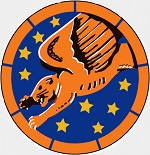Hobby Master HA7745 USAAF North American P-51K Mustang Fighter - "Tall In the Saddle", 99th Fighter Squadron "Tuskegee Airmen", 332nd Fighter Group, Italy, 1945 (1:48 Scale)
"Spit Fire"
- Motto of the Tuskegee Airmen
 No other aircraft of WWII could fly as high, go as far, or fight as hard as the famed Mustang. Piloted by a record 281 Aces, this agile and ferocious dogfighter tallied more kills than any other Allied airplane. As the bombers of the Eighth Air Force fought their way deep into Hitler's Germany, it was the Mustang that cleared the skies of Luftwaffe fighters. The powerful Rolls-Royce Merlin engine gave the Mustang a speed of 445 mph. Re-styled with an aerodynamic bubble canopy for greater visibility, and outfitted with 6 fast-firing .50 caliber machine guns, the P-51 became the best fighter of the war.
No other aircraft of WWII could fly as high, go as far, or fight as hard as the famed Mustang. Piloted by a record 281 Aces, this agile and ferocious dogfighter tallied more kills than any other Allied airplane. As the bombers of the Eighth Air Force fought their way deep into Hitler's Germany, it was the Mustang that cleared the skies of Luftwaffe fighters. The powerful Rolls-Royce Merlin engine gave the Mustang a speed of 445 mph. Re-styled with an aerodynamic bubble canopy for greater visibility, and outfitted with 6 fast-firing .50 caliber machine guns, the P-51 became the best fighter of the war.
The P-51K Mustang was essentially a P-51D with a different propeller. With war production at max capacity in Inglewood, NAA added P-51 production at their Dallas Texas plant starting with the P-51B. The new designation of the B models built in Dallas was P-51C.
When the P-51D began production, once again the Dallas plant was needed. Unlike the B models, when the D models were built in Dallas, their designation of "D" was kept. They were identified as built from the Dallas plant with the "NT" suffix. So a -5 block of a D model Mustang built in Dallas would be a P-51D-5NT. These were identical to a P-51D-5NA, built in Inglewood, Ca.
Pictured here is a 1:48 scale replica of a USAAF North American P-51D Mustang fighter that was nicknamed "Tall In the Saddle", and attached to the 99th Fighter Squadron "Tuskegee Airmen", 332nd Fighter Group, then deployed to Italy during 1945.
Sold Out!
Dimensions:
Wingspan: 8-1/2-inches
Length: 7-1/2-inches
Release Date: November 2020
 Historical Account: "Tuskegee Airmen" - The 99th Fighter Squadron supported Allied invasions of Sicily and Italy and provided close air support to the U.S. 5th Army during its assaults on Foggia and Anzio and for French and Polish armies in their attack on Monastery Hill near Monte Cassino. On January 27th and 28th, 1944, Luftwaffe Fw 190 fighter-bombers raided Anzio, where the Allies had conducted amphibious landings on January 22nd. Attached to the 79th Fighter Group, eleven of the 99th Fighter Squadron's pilots shot down enemy fighters, including Captain Charles B. Hall, who claimed two shot down, bringing his aerial victory total to three. The eight fighter squadrons defending Anzio together, claimed 32 German aircraft shot down, while the 99th claimed the highest score among them with 13.
Historical Account: "Tuskegee Airmen" - The 99th Fighter Squadron supported Allied invasions of Sicily and Italy and provided close air support to the U.S. 5th Army during its assaults on Foggia and Anzio and for French and Polish armies in their attack on Monastery Hill near Monte Cassino. On January 27th and 28th, 1944, Luftwaffe Fw 190 fighter-bombers raided Anzio, where the Allies had conducted amphibious landings on January 22nd. Attached to the 79th Fighter Group, eleven of the 99th Fighter Squadron's pilots shot down enemy fighters, including Captain Charles B. Hall, who claimed two shot down, bringing his aerial victory total to three. The eight fighter squadrons defending Anzio together, claimed 32 German aircraft shot down, while the 99th claimed the highest score among them with 13.
The squadron earned its second Distinguished Unit Citation on May 12th-14th, 1944, while attached to the 324th Fighter Group, attacking German positions on Monastery Hill (Monte Cassino), attacking infantry massing on the hill for a counterattack, and bombing a nearby strong point to force the surrender of the German garrison to Moroccan Goumiers.
In mid-1944 the squadron was assigned to conduct bomber escort missions. The unit supported bomber missions over Romania, France, Austria, Czechoslovakia, Poland, Yugoslavia and Greece. For its efforts during the war the squadron was awarded three Distinguished Unit Citations.


